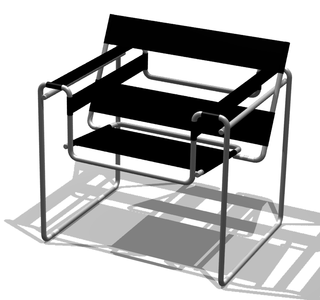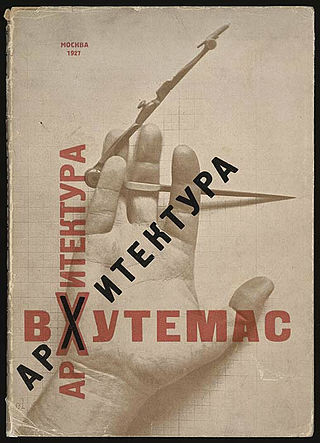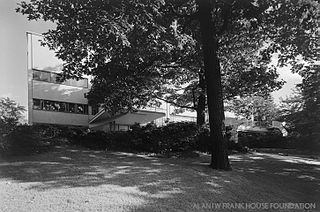
The Staatliches Bauhaus, commonly known as the Bauhaus, was a German art school operational from 1919 to 1933 that combined crafts and the fine arts. The school became famous for its approach to design, which attempted to unify individual artistic vision with the principles of mass production and emphasis on function.

Modern architecture, or modernist architecture, was an architectural movement or architectural style based upon new and innovative technologies of construction, particularly the use of glass, steel, and reinforced concrete; the idea that form should follow function (functionalism); an embrace of minimalism; and a rejection of ornament. It emerged in the first half of the 20th century and became dominant after World War II until the 1980s, when it was gradually replaced as the principal style for institutional and corporate buildings by postmodern architecture. According to Le Corbusier the roots of the movement were to be found in the works of Eugène Viollet le duc.

Josef Albers was a German-born artist and educator. The first living artist to be given a solo show at MoMA and at the Metropolitan Museum of Art in New York, he taught at the Bauhaus and Black Mountain College, headed Yale University's department of design, and is considered one of the most influential teachers of the visual arts in the twentieth century.

A desk or bureau is a piece of furniture with a flat table-style work surface used in a school, office, home or the like for academic, professional or domestic activities such as reading, writing, or using equipment such as a computer. Desks often have one or more drawers, compartments, or pigeonholes to store items such as office supplies and papers. Desks are usually made of wood or metal, although materials such as glass are sometimes seen.
Parsons School of Design, known colloquially as Parsons, is a private art and design college located in the Greenwich Village neighborhood of New York City. Founded in 1896 after a group of progressive artists broke away from established Manhattan art academies in protest of limited creative autonomy, Parsons is one of the oldest schools of art and design in New York. Parsons is consistently ranked one of the best institutions for art and design education in both the United States and the world.

Néo-Grec was a Neoclassical Revival style of the mid-to-late 19th century that was popularized in architecture, the decorative arts, and in painting during France's Second Empire, or the reign of Napoleon III (1852–1870). The Néo-Grec vogue took as its starting point the earlier expressions of the Neoclassical style inspired by 18th-century excavations at Pompeii, which resumed in earnest in 1848, and similar excavations at Herculaneum. The style mixed elements of the Graeco-Roman, Pompeian, Adam and Egyptian Revival styles into "a richly eclectic polychrome mélange." "The style enjoyed a vogue in the United States, and had a short-lived impact on interior design in England and elsewhere."

Eileen Gray was an Irish architect and furniture designer who became a pioneer of the Modern Movement in architecture. Over her career, she was associated with many notable European artists of her era, including Kathleen Scott, Adrienne Gorska, Le Corbusier, and Jean Badovici, with whom she was romantically involved. Her most famous work is the house known as E-1027 in Roquebrune-Cap-Martin, France.

The Wassily Chair, also known as the Model B3 chair, was designed by Marcel Breuer in 1925–1926 while he was the head of the cabinet-making workshop at the Bauhaus, in Dessau, Germany.

Marcel Lajos Breuer, was a Hungarian American modernist architect and furniture designer. He moved to the United States in 1937 and became a naturalized American citizen in 1944.

Florence Marguerite Knoll Bassett was an American architect, interior designer, furniture designer, and entrepreneur who has been credited with revolutionizing office design and bringing modernist design to office interiors. Knoll and her husband, Hans Knoll, built Knoll Associates into a leader in the fields of furniture and interior design. She worked to professionalize the field of interior design, fighting against gendered stereotypes of the decorator. She is known for her open office designs, populated with modernist furniture and organized rationally for the needs of office workers. Her modernist aesthetic was known for clean lines and clear geometries that were humanized with textures, organic shapes, and colour.

Vkhutemas was the Russian state art and technical school founded in 1920 in Moscow, replacing the Moscow Svomas.

Jean Prouvé was a French metal worker, self-taught architect and designer. Le Corbusier designated Prouvé a constructeur, blending architecture and engineering. Prouvé's main achievement was transferring manufacturing technology from industry to architecture, without losing aesthetic qualities. His design skills were not limited to one discipline. During his career Jean Prouvé was involved in architectural design, industrial design, structural design and furniture design.

Modern furniture refers to furniture produced from the late 19th century through the present that is influenced by modernism. Post-World War II ideals of cutting excess, commodification, and practicality of materials in design heavily influenced the aesthetic of the furniture. It was a tremendous departure from all furniture design that had gone before it. There was an opposition to the decorative arts, which included Art Nouveau, Neoclassical, and Victorian styles. Dark or gilded carved wood and richly patterned fabrics gave way to the glittering simplicity and geometry of polished metal. The forms of furniture evolved from visually heavy to visually light. This shift from decorative to minimalist principles of design can be attributed to the introduction of new technology, changes in philosophy, and the influences of the principles of architecture. As Philip Johnson, the founder of the Department of Architecture and Design at the Museum of Modern Art articulates:
"Today industrial design is functionally motivated and follows the same principles as modern architecture: machine-like simplicity, smoothness of surface, avoidance of ornament ... It is perhaps the most fundamental contrast between the two periods of design that in 1900 the Decorative Arts possessed ..."

Gunta Stölzl was a German textile artist who played a fundamental role in the development of the Bauhaus school's weaving workshop, where she created enormous change as it transitioned from individual pictorial works to modern industrial designs. She was one of a small number of female teachers on the Bauhaus' staff and the first to hold the title of "Master".
Jean-Michel Frank was a French interior designer known for minimalist interiors decorated with plain-lined but sumptuous furniture made of luxury materials, such as shagreen, mica, and intricate straw marquetry. He had an eye for exotic patterns, specifically in veneers, including snake and sharkskin. His work became widely known in the 1930s when select, higher classes demanded his furniture. He is known for being associated with the Art Deco movement.
Gilbert Rohde (1894–1944), whose career as a furniture and industrial designer helped to define American modernism during its first phase from the late 1920s to World War II, is best known today for inaugurating modern design at Herman Miller Inc.

The Alan I W Frank House is a private residence in Pittsburgh, Pennsylvania, designed by Bauhaus founder Walter Gropius and partner Marcel Breuer, two of the pioneering masters of 20th-century architecture and design. This spacious, multi-level residence, its furnishings and landscaping were all created by Gropius and Breuer as a 'Total Work of Art.' In size and completeness, it is unrivaled. It was their most important residential commission, and it is virtually the same today as when it was built in 1939–40, original and authentic.
Parsons Paris is a degree-granting school of art and design in the 1st arrondissement of Paris, France. It is the European branch campus of Parsons School of Design and part of The New School, a comprehensive university in New York City.
Margaretha Reichardt, also known as Grete Reichardt, was a textile artist, weaver, and graphic designer from Erfurt, Germany. She was one of the most important designers to emerge from the Bauhaus design school's weaving workshop in Dessau, Germany. She spent most of her adult life running her own independent weaving workshop in Erfurt, which was under Nazi rule and then later part of communist East Germany.

Alma Siedhoff-Buscher, born Alma Buscher, was a German designer. She trained at the Reimann School in Berlin, the Unterrichtsanstalt des Kunstgewerbemuseums Berlin and the Bauhaus.















